For the Wildlife Department, the conservation of Oklahoma’s natural resources is a labor of love.
Every workday, Wildlife Department biologists and technicians manage habitat and improve Oklahoma’s public hunting and fishing opportunities; game wardens safeguard the state’s fish and wildlife; communication and education specialists share outdoor stories and train incoming hunters and anglers; and the suite of accountants, license assistants, federal aid and IT specialists, and property managers make sure the agency runs smoothly.
We’re excited to share updates from our work in 2023, but the following conservation highlights are just that — snapshots of a year in the life of your Wildlife Department. Sign up for email updates or follow us on social media, @okwildlifedept, to learn more about our conservation efforts throughout the year.
Fish and Wildlife Studies
Enhancing Oklahoma’s fish and wildlife resources is one of the Wildlife Department’s leading charges. To meet this target, biologists regularly conduct surveys and collaborate with partners to learn more about the status of certain populations, their habitat needs, and best management practices.
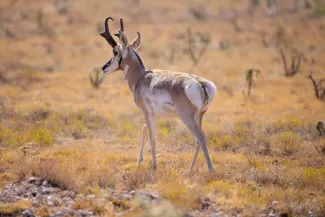
The pronghorn is just one of the species the Wildlife Department and its partners are studying this year. ? Click to watch a short clip of the Wildlife Department’s annual pronghorn survey.
In 2023, land-based surveys expanded beyond the annual efforts to monitor upland game birds, furbearers, and white-tailed deer to include secretive crawfish frogs, threatened and endangered bats, and the state’s breeding bird and bumble bee communities. Our partners in conservation also worked to help us understand the population stability and movements of American alligators, black bears, and pronghorns; the dynamics of Oklahoma’s wild turkey and mule deer populations; and helped boost the state’s last remaining population of endangered red-cockaded woodpeckers.
On the water front, intensive annual fish sampling efforts were conducted at dozens of lakes and reservoirs to assess the status, and age and size structure of various fish species; surveys were carried out at more than 50 sites to learn about the fish communities of the Deep Fork and Neosho watersheds; federally threatened fish were monitored alongside U.S. Fish and Wildlife Service and U.S. Forest Service personnel; and biologists and technicians engaged anglers in creel surveys to evaluate the state’s fishing opportunities.
Habitat Management on Public Lands
The Wildlife Department manages more than 100 public hunting and fishing areas, totaling nearly 1.4 million acres. These areas aren’t just devoted to Oklahoma’s fish and wildlife, they’re also set aside for hunters, anglers, and wildlife enthusiasts.
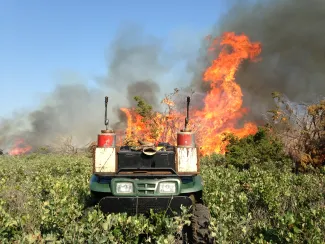
Prescribed fire is one of the Wildlife Department’s principal management tools.
This year, land management goals were adjusted around drought conditions in the early months and heavy rains in parts of the state later in the spring. Despite a series of burn bans during the traditional “burn season,” prescribed fire was used to improve habitat on more than 45,000 acres of Wildlife Management Areas statewide. Additionally, WMA staff and contractors worked to remove cedars, mulch cedars and other vegetation growing under wild turkey roosts, and apply herbicide to maintain woody growth and manage invasive plants on more than 7,000 acres.
The Wildlife Department also worked with producers to graze more than 125,000 acres and put nearly 50,000 acres into planted crops. These leases not only help manage vegetation on WMAs but generate revenue that supports conservation efforts.
Dam inspections were also completed in 2023 — with repair work on both Jap Beaver and Watonga reservoirs on schedule to finish in 2024 — along with a variety of projects to improve the state’s aquatic habitats. Catfish spawning boxes were installed; a water vegetation removal vehicle, or “Weedoo,” was used to maintain several Close to Home fishing areas; and a pilot project was launched to install artificial fish habitat in reservoirs to improve angling opportunities.
Improved Shooting and Fishing Access
The Wildlife Department is committed to making sure there are public places for outdoor enthusiasts to shoot and fish in Oklahoma. As part of a long-term effort to improve access, ODWC completed the construction of two shooting ranges and one courtesy fishing dock in 2023.
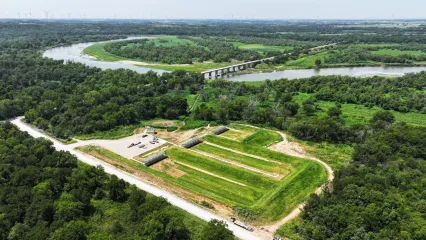
Major improvements have been made to the Wildlife Department’s publicly accessible shooting ranges, including a newly constructed range at Kaw WMA, shown in this aerial view. (A $32 annual hunting license gives access to the 14 public ranges found across the state for the calendar year in which it is purchased.)
The newly constructed range at Packsaddle WMA features a 100-yard rifle range with five covered benches and a trap range, while the range at Kaw WMA features two 100-yard rifle ranges with 12 covered benches, a 30-yard pistol range with six covered benches, and an archery range with a tower and four shooting lanes.
To increase opportunities for recreational boating and sport fishing, a new 8-foot by 26-foot courtesy fishing dock with a 64-foot gangway was installed at Fort Cobb Reservoir at the Fly Inn 2 boat ramp area this fall. The groundwork has also begun on similar courtesy docks for Stroud Lake and Lake Ellsworth at Collier’s Landing. No boat launch fees will be charged for these facilities.
Sharing the Tradition
To grow an active, passionate, and knowledgeable outdoor community, the Wildlife Department offers a multitude of educational programs and partners with public and private schools to incorporate hunting and fishing techniques into their curricula.
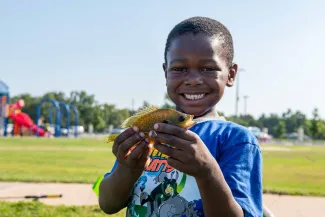
Fishing clinics are just one of the ways the Wildlife Department connects Oklahomans with the joys of being outdoors.
More than 50,000 students were trained in archery, bowhunting, shotgun shooting, and fishing skills through the Wildlife Department’s in-school Outdoor Education Programs in 2023, and nearly 3,500 participants were introduced to shotgun shooting through the Shotgun Training Education Program. While outdoor safety is featured in each of the education programs, Wildlife Department employees and volunteers also hosted nearly 100 full-day hunter education courses and certified more than 6,000 students. In addition to these training courses, more than 3,000 outreach programs were held this year, introducing the public to the amazing species that can be found in the state; fish and wildlife regulations; and what it’s like to work in the field of conservation.
Safeguarding Oklahoma’s Fish and Wildlife
More than 100 game wardens patrol Oklahoma’s 77 counties, ensuring the state’s fish and wildlife laws are observed.
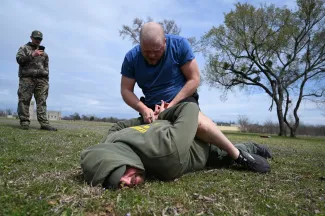
Training and officer safety is a priority for every game warden.
In addition to conducting public outreach programs across the state, Oklahoma game wardens spent nearly 90,000 hours on patrol in 2023, connecting with more than 50,000 sportsmen while in the field. They answered hunter and angler questions; responded to trespassing calls; and issued citations, warnings, temporary licenses, and administrative fines as needed in about 10% of their compliance checks. Wardens also spent more than 6,000 hours investigating fish and wildlife violations, and successfully closed the 2021 investigation of four illegally killed whooping cranes. Training was another priority, accounting for 13,000 hours of time, and included a nine-week academy for new wardens.
How Conservation is Funded
Hunters, anglers, and outdoor enthusiasts have been steadfast sponsors of conservation work across the nation. In Oklahoma, the Wildlife Department does not receive any state-appropriated tax dollars. Instead, hunting and fishing license dollars unlock a pool of federal grants generated by excise taxes collected on certain hunting and fishing equipment purchases. Other licenses like the Wildlife Conservation Passport and revenue from agricultural and oil leases can also be used to match federal grants.
Outdoor enthusiasts can continue to support the Wildlife Department’s work in a number of ways – from buying a hunting or fishing license, to making a purchase in the Go Outdoors Oklahoma shop or ordering a wildlife conservation specialty license plate, to making a direct donation. While financial support helps put conservation plans into action, there are other great ways to support conservation in Oklahoma. Hunters and anglers can mentor incoming conservationists; naturalists can share their fish and wildlife sightings on free platforms like eBird and iNaturalist; and everyone can share about Oklahoma’s incredible species and conservation actions.
The Wildlife Department is thankful to manage and protect fish and wildlife, along with their habitats, and to be part of Oklahoma’s dedicated conservation community. We hope you’ll continue to support our labor of love.